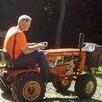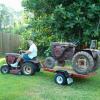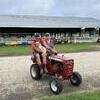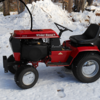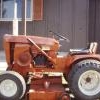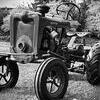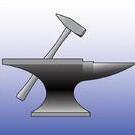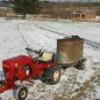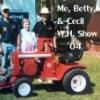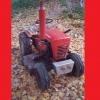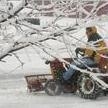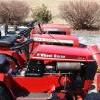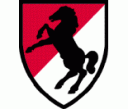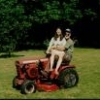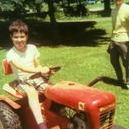Leaderboard
-
in all areas
- All areas
- Markers
- Marker Comments
- Marker Reviews
- Articles
- Article Comments
- Article Reviews
- Classfieds
- Classified Comments
- Classified Reviews
- Wiki's
- Wiki Comments
- Wiki Reviews
- Blog Entries
- Blog Comments
- Images
- Image Comments
- Image Reviews
- Albums
- Album Comments
- Album Reviews
- Files
- File Comments
- File Reviews
- Posts
-
Month
-
All time
November 28 2011 - January 16 2026
-
Year
January 16 2025 - January 16 2026
-
Month
December 16 2025 - January 16 2026
-
Week
January 9 2026 - January 16 2026
-
Today
January 16 2026
- Custom Date
-
All time
Popular Content
Showing content with the highest reputation since 12/16/2025 in all areas
-
25 pointsI figured I should get in a ride while the getting is good because of the uncertain weather conditions nowadays. I used the Side x Side to pack roughly 6 '' of snow on the ground. The 418-A is my mowing tractor and it's nice to get behind the wheel with no mower deck and wind it up some. This was on Thursday after lunch.
-
24 pointsMerry Christmas from the PeacemakerJack family. This is Coulter Caleb’s new house and his fiancée Faith (sitting on her 314H) along with the rest of our family. We started taking these Christmas tractor pictures 11 years ago…a lot has changed since that first picture. I’m so thankful for the many memories made through the years. As Tiny Tim observed, “God bless us…every one!”
-
24 points.. NATIONAL FLASHLIGHT DAY!!! @953 nut how could you have missed this one . Yeah yeah, maybe it’s because I have 200 or so old flashlights here, many are over 100 years old. “National Flashlight Day is celebrated on December 21, coinciding with the winter solstice, the longest night of the year. This day highlights the importance of flashlights, a simple yet essential tool in our lives. Originating from the invention of the dry cell battery and the mini incandescent light bulb, flashlights have illuminated our paths in darkness and served various practical purposes. National Flashlight Day not only celebrates the utility of the flashlight but also aligns with the winter solstice, emphasizing the significance of light during the darkest times.”
-
23 pointsSome of you members who go to the Wheel Horse show, know my Grandson Mason. Well on December 14, we had our first snow, and Mason has his first time driving in it. Unfortunately, he and his Subaru Outback had an untimely meeting with an F-350 pickup truck, his own. This was in the driveway. The F-350 won. He was quite upset but said that it would be back on the road in time for reopening of schools. So, Mason did not want to report it to insurance for obvious reasons, and he did not want to take it to a body shop, so he proceeded to disassemble it. After determining there was no frame or engine damage, he started his search for parts. He found a bumper cover, left fender, and hood, all the same color. He purchased a new core support and radiator, two new headlights, and a grill. He brought the car over to my house yesterday. The whole job was done outside in 15 to 35 degree weather. Total cost? $1400. That's perseverance.
-
22 pointsHere I go again. As the title says, this years project is a 401 Suburban. Will start off with some ground 0 pics. Next step that I was happy about was my Christmas Miracle. The steering wheel came off without special tools or much resistance. When I bought the tractor it had a Nova ignition module on it. Starting it was sometimes a challenge so I wanted to switch it back to points before disassembly. Happy to say that it starts much better on points than it did with the Nova module. With this accomplished it was time to move on to tear down. A couple of hours later & I had a pile of parts. I went through the transmission shortly after I bought the tractor because it had a 3rd gear issue, so that will not have to come apart again. The engine runs good with no smoke, so hopefully it will not need a rebuild. It does appear to be seeping oil from the head gasket, so I will pull the head to change the gasket. Will also inspect cylinder condition as long as it's open. Now for some P.O. surprises. Lets just say that some people should not be allowed to play with welders. First, when a lock collar cracks I guess one should grab the welder & tack it in place. Drag link issue?? Lets burn that in place too. I'm sure there will be a few more surprises. Feel free to come along for the show.
-
22 pointsDid something crazy today! Drove 735 miles from Andover Ct to Shippensburg Pa (round trip) took me 13 hours and 10 minutes, spending $130.24 on fuel…to come home with a C-145 Hydro. My wife packed me a lunch, snacks and a couple waters so I only had to purchase a coffee. Left my house at 5:30am and pulled back into my driveway at 6:40pm. Was supposed to be a clear day…hardly! Hit snow on I84 west headed to Scranton Pa, and hit it again on the way home . But no hiccups or truck issues so I’ll say it was a win!
-
21 points
-
21 pointsThere was a fair amount of wear on the ends of the C81 Clutch Shaft where it goes thru the frame. Metal on metal, no bearings & not easily lubricated. I installed the bronze bushings on the 502 frame a while back, using the milling machine. The C Series has two sets of welded 3/4" diameter rods to hold the foot rests, the rear ones were in the way - could not do this in the milling machine. There were 3 choices - cut the rear rods off & reweld them later, do the work by hand, or - break out the 1950's ShopSmith 10E and use it. I went with option #3 - while the assembly & setup are extensive, it gives the best results. Pictures are for the RH bearing: the setup needs to come apart and be reassembled opposite hand to do the left.
-
20 pointsI built a hub puller a couple of weeks ago, which worked great (see below), but I thought I could improve upon it, so I fabbed up a new version, which has two advantages over the first one: It has a cavity for the hub spigot, so it can be bolted flat against the hub flange, which can add some rigidity to the flange, and it can be used with hubs that have been retrofitted with studs, as well as those that are still using lug bolts. Mine still has lug bolts, but I used a separate set of bolts and washers with the puller, rather than the lug bolts, in order to prevent any damage to the puller plate or to the tapered part of the lug bolts. The center bolt is longer than it needs to be, but that's what I had on hand. I put a dab of anti-seize on the center bolt threads. Previous version of hub puller: New version: Back of puller (I dressed the weld a bit, just for the heck of it): Front of puller:
-
19 pointsWe got a few inches of the white stuff today, daytime temps in the 20's. Used all three of the seasoned "Snow Angels" - 1979 C81, 1964 854 8 Speed, and the 1976 Ariens 24" Snow-Thro. The Snow Shovel not shown has only 8 years on the job, gets an "Honorable Mention" ...
-
19 pointsMaybe not. Looked out in the back yard last night to see a black bear working on the bird feeders. Opened the door and asked him to leave ... he wandered off but was back 10 minutes later.. Today I went out to find the feeders and see where he had been. We are having some work done and the contractor has a dumpster and a porta-potty. set up. Bear tracks went right up to the door of the porta-potty
-
17 points
-
17 pointsDon't want to jinx anyone here in Maine but have not seen piles of snow here this high in a few years. This was cleaned up with multiple machines. Good ole time Maine Wintah.
-
17 pointsThe right-rear axle seal in my 522xi failed rather suddenly, as evidenced by the oil slick that appeared overnight on the garage floor. I jacked up the rear end and checked for play in the bearing, as well as end play in the axle. All was snug and smooth, so I figured that the rubber portion of the seal probably split or became detached from its metal ring. So, off with the hub. I loosened the set-screw jam nuts, heated the set screws just enough to soften up the factory-applied thread-locking compound, and removed them, using a 3/8” square (4-point) socket. I was going to use a three-jaw puller to remove the hub, as shown in the service manual. However, the hub appears to be cast iron, and I saw that some forum members had broken a hub flange with a puller. I could have used a bearing separator to pull the hub by flipping the jaws front-to-back and placing it directly right behind the flange, contacting the hub reasonably close to the center, but I opted for a more ‘elegant’ solution: I made a custom hub-puller that I could use again for future repairs if/when needed. It didn't take long to make. I traced the wheel hole pattern onto a scrap piece of 3/8" steel plate, drilled five 15/32” holes (for 7/16” bolts), drilled a 25/32” hole in the center, and welded a 3/4” grade 8 nut to the plate. I would have made the plate round, but I didn't have a wide enough piece of 3/8" plate, so it's in the shape of a pentagon. I figured that pulling from five points instead of three, and with those points closer to the center of the hub than its edge, there wasn’t much chance of breaking the casting. Also, before applying any pulling force, I snugged up all five of the 7/16” bolts finger-tight to make sure it would pull evenly from all five points. It worked “slick as snot on a glass doorknob,” as an old employer of mine used to say. As I suspected, the rubber portion of the seal had partially separated from its steel outer ring. I pried the seal out, being careful not to scratch the axle or transmission mating surfaces. I also checked for burrs on the axle, to avoid scratching the new seal when installing it. I made a simple seal installation tool by turning down a piece of schedule 80 PVC pipe in my lathe, which worked fine for installing the new seal. I’ll improve that tool later by inserting a thin sleeve inside it for a closer fit over the axle. Here's my hub service 'kit,' consisting of the puller, the 3/8" square socket, and the plastic seal installer, which I'll keep together in a bin for later use. I re-installed the original plastic thrust washer, which had a few thousandths of wear, but was still in good condition. I also installed a new key, even though the old one looked fine, and I cleaned and dried the set screw threads in the hub, so that the Loctite would work properly. The hub was still a snug fit on the axle, and I tapped it into place with a dead-blow plastic hammer to the point where there was only about .002 or .003 inch of end play in the axle (in other words, I tapped the hub far enough on to the axle to make up for the slight wear in the plastic thrust washer). I then installed new grade 8 square-head set screws with Loctite 271, torqued them per the service manual specs (28-32 ft. lbs.) and tightened the jam nuts. Done, no leaks, and I have a tool that will make any future hub work easier.
-
17 pointsThe leads going to the cruise control electromagnet on my 522xi showed definite signs of having served as a meal or nesting material for a mouse or some small furry critter. All but one or two strands of the wire were chewed through: Not a difficult repair job. Cut/strip/crimp: First layer of heat-shrink tubing: Second layer of heat-shrink tubing: Wires fixed. I managed to clean and save most of the original outer jacket/loom: Electromagnet reinstalled: Rounded up the usual suspects, but had to let this one go for lack of evidence:
-
16 pointsSo as may of you know in September I bought a 1257. We fully rebuilt the transmission. I got a new ignition switch a few weeks ago and put that in. Then we got snow so it got pushed to the back. Today we finally brought it back in. Cleaned the points and it fired right up. More to come later today. IMG_1453.mov
-
16 pointsTodays adventure - rebuild the steering system. To start off I turned a portion of 5/8" stock down to 9/16" and threaded it to 12 pitch. Next drill a hole in it and tap the inside of it to 3/8-24. Then use a parting tool to cut it to length. OK, what am I building here ?? Remember the fan gear that the PO messed up by welding the drag link to it? The hole in it was too large for a heal-a-coil. So I tapped the hole in it to 9/16-12. What I made was an insert to repair the require 3/8-24 hole in the fan gear. Inserted with Loctite plus I peened the edges to ensure that it does not move. Next - take a peace of 5/8" x 4.5" stock, turn a 15/16" length of each end down to 7/16" and thread it to a 20 pitch. One new drag link. Now for the tie rod that was butchered up. First off, position the front axle and spindles so that everything is held strait. Then cut a 1" x 5/16" flat bar to length. Use a transfer punch to mark the outer holes. Drill the 1/2" holes in each end and the 3/8" hole for the drag link and test bolt things together. Looking good, now it was time to turn the two 1/2' bolts into part #3949 clevis pins. Cut to length and then drill an 1/8" hole 1" deep into the end of the bolt. Drill & tap the end to 1/4-28 to a depth of 3/8" for a grease zerk. Drill an 1/8" cross hole to meet up with the 1/8" length wise hole so that grease can get to the pivot point. Front end repaired & almost ready for some paint.
-
16 pointsHappy New Year everyone !!! With the day off I figured I'd take advantage of getting paid to work on my own stuff. A little progress report for y'all. First off I degreased the parts so that they would be ready for the blast cabinet. With the dishes done it was time to move on to repairs. First off get the drag link that a PO welded to the fan gear removed. Hood stand had some fatigue cracks that needed to be addressed. Tool box also had some fatigue cracks. Drilled some holes at the end of the cracks, beveled them out & welded them up. @AlexR was recently asking about spindle repairs. The spindles on this tractor had some pretty severe wear. I welded these then trimmed them back down to size with a grinder & a file. Bearing now fits snug on the spindle. That's all for today.
-
16 pointsI had my doubts this 16(14) Automatic "Johnny Cash" would ever be anything other than a parts donor, but here we are!
-
16 pointsWeld da hood shut baby. No more trouble wid dis one. Dry as mojave and purring like a kitten..
-
16 pointsI wonder if she ever said “Is that a flashlight in your pocket, or are you just glad to see me?” 🤣🤣🤣
-
15 pointsI ran into DJ this morning, and he even bought me lunch and a coffee! Thanks @hcminis, it was great to run into a familiar face after a 4 hour drive for some car parts!
-
15 pointsChanged out the powered worm gear snowblower chute with a powered chain drive.
-
15 pointsAll: Having "moved" both spindle bores when I machined it for bushings, I realized I now needed slightly shorter length Tierods. I have used regular 1080 Cold Rolled material for another set, but the quality of the machined threads was lacking. This set I switched to 12L14 "leaded" hexstock - per the certificate it has .27% lead in the alloy. This allows easier machining with a superior finish. Cost is just a couple of bucks more than 1080. The threads shown are done with an adjustable thread cutting die - 3 passes needed to get the proper shaft to nut fit. Shown is the die from the final pass - the chips look like angel hair Also shown is the old trick of having a starting pilot diameter for the die - it is removed once the threading is done. The 12L14 material is safe to work with, but sanding, grinding and welding are NOT recommended...
-
15 pointsPut a new brake pedal return spring on my '75 B100 Auto a couple weeks ago and when I was done the engine wouldn't crank with the ignition switch. No click, nothing, but I could turn the key to the run position, jump the solenoid and it would start right up and keep running. Switch tested good and I tried another known good one, same for the solenoid. The seat saftey switch was long gone when i got it. I replaced a sketchy looking splice in the lead to the solenoid and also put a new terminal on it. I did find that somewhere in all this the terminal for the battery negative cable had snapped off where it was fastened to the frame so I put a whole new cable on, still nothing. I had continuity across the switch but when I checked from the switch to the solenoid nada. I pulled the rectifier/ammeter mounting plate to take a look at the wiring to the switch from there. Ammeter had been bypassed years ago. I had juice from the switch to the rectifier but nothing to the feed running to the solenoid. I started to suspect the PTO safety switch...... That's when it hit me, I gave the PTO lever a pull and it moved backward, it had gotten bumped forward just enough to break the circuit..... put it all the way back, hit the key and it spun right over. Realizing I'm a moron never felt quite so good LOL. I did however take care of at least 3 future wiring problems so it wasn't a total loss. Thought I'd share that, always make sure everything is in the off position even if you "know" it is. All it took in this case was a few degrees of rotation and my total confidence it was an actual electrical issue..
-
15 pointsStuck these lights on the 1257 today just to see what they look like. The holes are already there so dont know if I want to fill them in, leave them alone, or run these lights? They would be handy in the dark of night . What is everyone’s opinion?
-
15 pointsPictured below is a gift and card (on nothing less than notebook paper.) my ten year old granddaughter gave me. She told me she bought me a Christmas gift (with her own money her mom said.) a couple of weeks ago. The school had some kind of sale and Gracelia found these pliers and snatched them up. The other side of the card said "TO: You FROM: Cece" These pliers will not likely be put to use on the 520H. They, along with the card, will be hanging on my "wall of memories" in the shop and remain there as long as I'm able to be out there tinkering around.
-
15 pointsIt’s back in action. Little better than I found it. Enjoy the YouTube video YouTube Video
-
15 pointsThe other day I picked up a No name 14 from a friend of mine who has been in this hobby a long time. I have been eyeing this machine for the last couple years. I did NOT need another machine by any means but gladly added this one to my collection! Pic right after I got it and once I got it home cleaned up with a new seat!
-
14 pointsEarly birthday present for myself. Not perfect, but for the price I couldn’t resist.
-
14 pointsA buddy who is a scrapper called about this hood he picked up with some other scrap metal. Thankfully he called to see if we wanted it. I don't have a use for it but couldn't see letting it get crushed. Pretty straight, no latch or wiring.
-
14 pointsPicked up an early Raider 12 just before Christmas. Seller said he had rebuilt the trans but it stopped moving while he was plowing snow and he thought he snapped the input shaft. That didn't sound quite right to me and I suspected the key for the drive pulley was a more likely suspect. We agreed on a price delivered. The tractor came with a 42" snow blade mounted, a 42" mower deck with only one small rust hole, and extra pair of rear wheels and tires and tire chains. He also threw in a Harbor Freight 20 Ton press. He dropped it off and while I was pushing it to the shed the left rear wheel and hub came off. I immediately thought that might be its mobility issue. I got the wheel back on and pushed it in the shed. I finally got to work on it today after work. I picked up a couple Woodruff keys and stuck one in, it also needed a battery. It starts easy, runs pretty good with no smoke or obnoxious noises AND it moves in all gears. It's seeping a little where the case halves meet and it has a catch going into reverse so I'll open it back up and take care of those items. The drive belt is in pretty rough shape too and when I put a load on it, it stopped moving until I let it sit for a minute for the belt to cool so I have a new one on the way. Plan is for this one to be my new mower and the blade will go on my old Raider 9 after an engine transplant. This is the seller's pic from the ad, not much to look at but it's all there and functional....
-
14 pointsHere ya go EB ... I ain't gonna tell ya some bozo threw this one on the scrap pile at my old shop...
-
14 points
-
14 points
-
14 pointsSacrilege or not I wanted some new wheels, tires, hubs, and lugs. Put old shoes on my L-156.
-
14 pointsWhy all the snowmen decorum, and not of me! I've been slighted and disrespected. I think Karl may get some coal in his stockings this year.
-
14 pointsReceived this much appreciated Tee Shirt today. It also relates to Tractors... enjoy! Percussive Maintenance - Stuck Carb Needle High Impedance Air Gap - Rectifier Connector fell off Cycle Power to the Panel - Battery Charger not working Thermally Reconfigured - The dreaded 9-Pin Connector Kinetic Disassembly - Balance Gear Failures
-
14 pointsI agree with Achto that too much weight may cause something mechanical to let go, a little tire slip is not a bad thing. I have a 1979 c-101 with (turf tires and 2 link chains) (best combo in my opinion for snow) 80 lbs on each rear wheel and # 40 chain on fronts for steering. A 10" cement block filled with cement, (weight unknown) on rear and have zero problem pushing as much snow as the plow can handle. It has been set up this way for 40 plus years with no mechanical problems, and has moved tons of western Pa snow ( Laurel Highlands). Bob
-
14 pointsHey guys, Well, greetings from way out here on the West Coast in California. Not too many members out here. I don’t think, seems like there weren’t a ton of our tractors here although mine is an original one owner Tractor before me who purchased it in Escondido California. (I’ve owned it for a decade). I have all of the records of everything, including the original bill of sale. It’s wonderful. Anyhow, today was day-one of disassembly, and as this has been a working Tractor for several years now, everything came apart beautifully. No frozen nuts. It has basically been effortless. So, all of my experience is with the restoration I did on CASE 444 tractor, But the nice thing is the similarities between the two for many things. I plan on upgrading the steering arms using Heim joints instead of the ball and socket joints… It was a huge improvement on my CASE. I’m sure I’ll have some questions going down the road, but the beautiful thing is I am finding almost zero corrosion, except the panel area inside… is that aluminum or magnesium? It’s got some powdery corrosion on it. Best to you all, Jason
-
14 pointsThe first notes are on papyrus ... that's an indication of how long @ebinmaine's been "working " on it... Trail cam of Eric ordering the first parts list...
-
13 pointsI love your AI paint job, and it inspired me. I've been having some fun playing with Photoshop and AI, and I thought I'd see what my GT18 would look like if it had a small V8 with a four-barrel, headers, mags, and racing slicks. Current (real) condition: After some AI-assisted modifications and a bunch more tweaking in Photoshop: And of course, it would be irresistible to the local bears:
-
13 pointsDecided ol' Johnny needed spruced up a bit, so I slapped a quick paint job on him. AI paint job, that is.
-
13 pointsThere are way too many "lower life forms" that sell WH parts on CL and FB Marketplace. They are not one bit interested in preserving the hobby, just the color of folding money. I have had mostly decent transactions on Fleabay - but the most accurate, knowledgeable and honest are the folks here on Red Square....
-
13 pointsDuring the winter months, I take to playing with the model train layout I've got in the basement. It's "L" shaped and is 11 feet by 22 feet. It's a great way to while away time when there's no grass to mow. The assisted living where mom lives has asked me to bring a train set up and leave it for them for a few days. If it's successful I'd like to do a snow scene next year. So I practiced making a small diorama. It's probably 24" square. I got a little heavy handed with the fake snow but it's learning as I go. This diorama is made of drywall compound, paste board boxes cut in strips, assorted paint, paper mache run through blender, wire and rope for trees and/or cuttings from trees in back yard and glue and some hair spray. I've probably got 8 or ten hours in this project.
-
13 pointsPut new 24-12-12 tires on C160. They are Horseshoe brand will try and post more info on them in lets talk tire thread.
-
13 pointsAfter a year of sweat, tears, and help from the forum. I'm done (enough) for now. After a few dicky electrical gremlins which I thought were solved, its not starting reliably, and ready to be put through it paces. And then in a year, I'll fix all the other stuff I'm not happy with.
-
13 pointsCelebrated on December 25th each year, Christmas Day is a holiday that commemorates the birth of Jesus Christ, who is the central figure of Christianity. It is a time for Christians around the world to come together and celebrate Jesus and the message of love, peace, and redemption that he brings. If you were a devoted viewer of MASH you will remember this one. If not, it is heartwarming and heart-wrenching at the same time and well worth watching. It may put a lump in your through or a tear in your eye, I find it very moving. Merry Christmas. https://www.youtube.com/watch?v=aEpkPF_X5UQ
-
13 pointsIt’s a warm day here in MA so I brought out the 1993 314-8 and the deck for a last cleaning of the season.
-
13 pointsLooks like a J.C. Whitney universal bumper add on hitch so you can tow a 10,000lb. trailer with 67 Dodge Dart!
This leaderboard is set to New York/GMT-05:00
-
Newsletter

